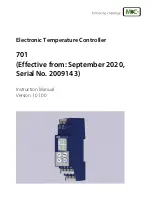
59/94
Siemens Building Technologies
Basic Documentation RVD110, RVD130
CE1P2381E
HVAC Products
17 Function block D.h.w. actuator 2
27.05.2004
This value is a guide value and can vary depending on the plant’s hydraulic layout. It is
recommended to start off with the calculated load limit and then
•
decrease the value if the d.h.w. flow temperature significantly overshoots when
d.h.w. is consumed
•
increase the value if the d.h.w. flow temperature significantly undershoots
When the load limit is reached, the control system takes on control of the actuator on
the primary side.
The end of d.h.w. consumption is also detected by the flow switch, and actuator Y5 on
the primary side will be overridden by a CLOSE signal.
17.4.8 Child-proofing
The child-proofing function ensures that when the hot water tap is repeatedly opened
within a short period of time, the load limit function will not respond more often than
necessary, thus preventing the d.h.w. from getting overheated.
If, within 10 seconds, the hot water tap is opened more than twice, the controller will
provide d.h.w. heating
without
the support of the load limit function.
17.4.9 Plants with no mixing circuit
This kind of control is implemented with plant type no. 4.
Controlled variable is the flow temperature in the d.h.w. circuit, which is acquired with
sensor B3. It is controlled by adjustment of the two-port valve in the primary circuit. This
kind of control necessitates a ”fast” actuator, preferably with a running time of 10...20
seconds.
To ensure that actuators with different opening and closing times provide the required
control performance, these 2 parameters can be entered separately (operating lines
111 and 112).
17.4.10 Plants with a mixing circuit
This kind of control is implemented with plant type no. 5.
Controlled variable is the flow temperature in the d.h.w. circuit, which is acquired with
sensor B3.
Control takes place in two stages, which ensures good control performance.
•
At stage 1, the flow temperature at the heat exchanger’s outlet is acquired with sen-
sor B3, which is then precontrolled by 2-port valve Y5 in the primary circuit
•
The second stage ensures fine tuning by adjusting mixing valve Y7
The use of a flow switch is not mandatory, but improves the control performance.
With plant type no. 5, maximum limitation of the temperature differential in the heating
circuit is not possible.
17.5 Instantaneous d.h.w. heating with storage
tanks
17.5.1 General
Instantaneous d.h.w. heating with storage tanks is covered by plant types no. 6 and
no. 7. In these plants, separate heat exchangers are used for space heating and d.h.w.
heating:
•
Plant type no. 6: Heating circuit heat exchanger and d.h.w. heat exchanger are con-
nected in parallel
•
Plant type no. 7: Heating circuit heat exchanger and d.h.w. heat exchanger are
connected in series
These applications require no flow switch.
Содержание RVD110
Страница 86: ...Siemens Building Technologies Basic Documentation RVD110 RVD130 CE1P2381E HVAC Products Index 27 05 2004 ...
Страница 92: ...92 94 Siemens Building Technologies Basic Documentation RVD110 RVD130 CE1P2381E HVAC Products 27 05 2004 ...
Страница 93: ...93 94 Siemens Building Technologies Basic Documentation RVD110 RVD130 CE1P2381E HVAC Products 27 05 2004 ...
















































